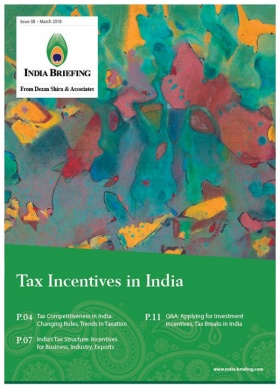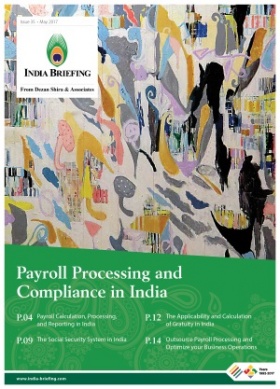GST Returns for Regular Business Entities in India
The Goods and Services Tax came into effect July 1, 2017. In the months since, the GST Council, responsible for monitoring the roll-out of this indirect tax, has made several clarifications and reforms to the original GST Act.
There are three components to GST:
- CGST – Central Goods and Services tax, levied on an intra-state sale and collected by the federal government.
- SGST – State Goods and Services tax, levied on an intra-state sale and collected by the state governments.
- IGST – Integrated Goods and Services tax, levied on an inter-state sale and collected by the federal government.
All GST returns have to be filed electronically, through a common e-portal provided by the Goods and Services Tax Network (GSTN). GSTN is a not-for-profit, private limited company, which provides the Indian government with information technology support for implementing the GST.
The GST Identification Number obtained when a company registers is required for all returns filing. Nil returns must also be filed on a monthly or quarterly basis.
Any business or professional entity in India with an annual turnover exceeding Rs 2 million (US$31,000), and Rs 1 million (US$15,500) in the northeastern states of India, will be required to obtain GST registration.
This article discusses the basic forms that have to be submitted by all regular business entities falling in the above criteria.
For an understanding of filing GST returns for specific cases, read our explanation of the GSTR-3B, the e-way bill, the Composition Scheme, GSTR 5 (non-resident taxable persons in India), GSTR 11 (diplomatic missions, UN personnel), GSTR 6 (input service distributors), GSTR 7 (tax deduction at source), and GSTR 8 (tax collection at source).
GSTR 1 – Form for outward supply
Every GST registered dealer needs to file the GSTR 1 form. It requires all the details of the sales made in that month. All invoices raised have to be uploaded onto the system. These can be edited until the GSTR 1 is submitted but any mistakes after submission can only be corrected in the next month.
Submit this form monthly – if the aggregate annual turnover of the business is above Rs 1.5 crore (US$ 230,550). Otherwise, it may be filed quarterly. Submission date is by the 10th of the next month.
This GSTR 1 is then sent to the buyer, who will file the GSTR 2. There is no tax payment made at this point.
GSTR-1A – Making changes in GSTR 1
Any changes made by the purchaser to the GSTR 1 form are reflected in the GSTR 1A, and will be verified by the supplier. Once these changes are accepted, the GSTR 1 form is filed.
GSTR 2 – Form for purchase transactions
GSTR 2 is a validation form for the GSTR 1 raised by the supplier. It is received as a GSTR-2A form, which when confirmed and filed is the purchaser’s GSTR 2.
In case of any discrepancies, the changes made will be reflected in the GSTR 1A and returned to the supplier for verification.
It is an invoice matching process.
The form needs to be submitted by the 15th of the next month.
GSTR 3 – Monthly return based on GSTR 1 and 2
GSTR 3 is a consolidation of GSTR 1 and 2. It is automatically generated to show the entire tax liability. This tax needs to be paid and returns filed on the GST portal. As per the Act, it needs to be submitted by the 20th of the next month.
GSTR-3B – Simple return until June 2018
GSTR-3B is an alternate form to the GSTR 3. The only difference is that no reconciliation between supplier and purchaser is necessary to file GST returns. The government recently released a simplified version of the form. This form has to be filed by the 20th of the next month for which GST is being calculated.
Forms GSTR 4, 5, 6, 7 and 8 are special returns to be filed by different categories of people.
GSTR 9 – Annual return
This form consolidates the returns made throughout the year. Details of sales and purchases under different tax types (SGST, CGST, and IGST) are furnished in this form. Any sales or purchases that have not been shown in the monthly filings can be corrected here. It is effectively a summary of the monthly/quarterly GST returns.
A statutory audit report has to be additionally submitted in case of companies and individual/HUF – if turnover exceeds Rs 10 million (US$153,700).
If the annual turnover exceeds Rs 20 million (US$307,400), GSTR-9C has to be filed instead of GSTR 9.
Such taxpayers also need to file an audit for the company’s annual accounts, and a reconciliation account of tax paid versus tax payable.
Submission for all annual returns is required by December 31 of the following tax year.
GSTR 10 – Final return
Any business whose GST registration has been cancelled or surrendered needs to file this form. It has to be filed within 3 months of cancellation or surrender. It is a one-time form for final GST settlement.
Penalty structure under GST
Penalty fees for delayed monthly returns is charged at Rs 50 (US$0.77) per day for GSTR 1, 3B, 4, 5, 6 and Rs 20 (US$0.31) per day for nil returns; the maximum being Rs 5,000 (US$76.70).
For GSTR 5A, the government recently reduced late fees to Rs 200 (US$3.07) per day of delay and Rs 100 (US$1.53) per day for nil returns; with a maximum penalty of Rs 5,000 (US$76.70).
For annual returns – GSTR 9, 9A, 9B, and 9C – the penalty is Rs 200 (US$3.07) per day of delay, or Rs 100 (US$1.53) per day for nil returns, up to 0.25 percent of the firm’s turnover.
The GST Council has also waived the late fee for the form GSTR-3B for the period of July to September 2017.
In addition, interest is calculated at 18 percent annually – starting from the day after the deadline – on the amount of outstanding tax.
Taxpayers should also note that the GST forms have to be filed in order. For example, the forms for January have to be filed before the forms for February. In case of outstanding non-compliance, late fees and interest charged can result in a cascading effect and a large accumulation of fines and taxes.
About Us
India Briefing is published by Asia Briefing, a subsidiary of Dezan Shira & Associates. We produce material for foreign investors throughout Eurasia, including ASEAN, China, Indonesia, Russia, the Silk Road, & Vietnam. For editorial matters please contact us here and for a complimentary subscription to our products, please click here.
Dezan Shira & Associates provide business intelligence, due diligence, legal, tax and advisory services throughout India and the Asian region. We maintain offices in Delhi and Mumbai and throughout China, South-East Asia, India, and Russia. For assistance with India investment issues or into Asia overall, please contact us at india@dezshira.com or visit us at www.dezshira.com.
- Previous Article GST Compliance for Input Service Distributors, TDS, TCS in India
- Next Article India’s Tax Incentives for Business, Industry, and Exports















